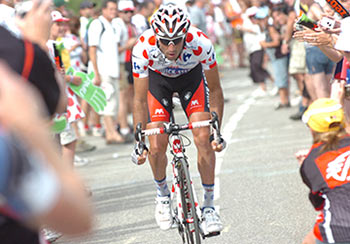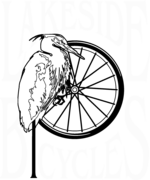Start Smart: Improve Your Road Climbing!
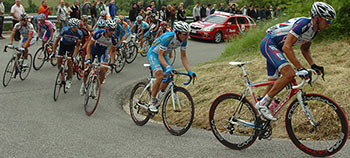
Even if you're just getting into cycling, you actually have something in common with the King of the Mountains in the Tour de France. Believe it or not, climbing feels the same to him as it does to you!
That's right: Pro riders feel the same discomfort in their legs as you do! Pedaling a bicycle uphill is hard work for all cyclists. It gets you out of your comfort zone, both mentally and physically.
But, the difference between you and the pros is that they have excellent technique, have hammered the hills for years and are super fit. Let's look at these champions to highlight key tips that work for them and that will help you climb better too.
Be Positive. One of the most basic ways to make hills easier is to always adopt a positive outlook when you see that bump on the horizon. Being negative only makes it harder. Smile and look forward to the challenge, and you'll actually enjoy even steep climbs and reach the summit with a sense of accomplishment rather than relief. It can help to remember that it's efforts like climbing that offer the calorie burning and strength building that's so beneficial in improving and riding better. It's one of the most valuable things you can do on a bike, in fact.
Practice. As with most aspects of cycling, the best way to improve your climbing is to practice it. Find some hills a couple of times a week and get to work. Climb a lot like this, go up different types of climbs (steep and short, long and shallow, rollers, etc.), climb with better climbers, climb with groups that push you to your limits. The high-torque and high-intensity effort of going uphill works your core area in different ways than riding the flats. By really practicing your climbing, you train the specific muscle groups required to climb stronger and will get better.
Vary Your Efforts in Training. Riding above your usual intensity level will lead to fitness gains and easier and faster climbing. Try mixing it up with different intensities. Alternate going really hard, then riding very easy, for a specified period of time, and repeating. This will make you fitter, burn lots of calories, and get your body accustomed to accelerating and recovering on ascents. Changing pace like this actually lets you rest a little. Plus, most hills aren't the same gradient throughout, so being able to stand up and vary your pace is a helpful technique.
Sit and Stand. Practice climbing while seated and while standing so you can do both smoothly. Most riders are naturally inclined to one or the other, but being able to do both will be beneficial. Staying in the saddle is more efficient for long climbs, and standing helps for short power bursts (like getting around a switchback or powering up the steepest part). Standing works different muscles and gives your back a break from the strain put on it by seated climbing. Here are more tips on when to sit and stand on hills:
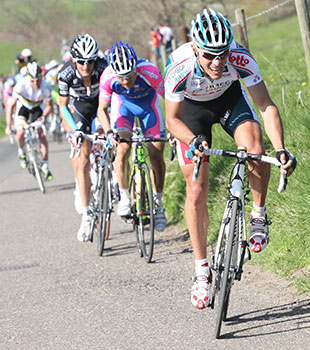
Choose Your Position!
1. For longer, steady efforts, stay seated with your hands on the tops of the bars. Keep your elbows bent and your upper body relaxed. To change gears, reach for the shifter, returning your hands to the tops when you're done.
2. For a break, to use different muscle groups and/or for more power to scale steep sections or accelerate, grip the brake hoods and stand. Rock your bike (not your body) beneath you with each pedal stroke using your body weight and legs to push. Basically, when one foot is pushing down, push out with the opposite hand. This should come naturally. Try imitating more experienced riders and you'll become fluid when you're standing.
3. Climb with your hands on the brake hoods while seated to open up your chest for easier breathing. This is also the position you should be in when you need instant access to the shifters. Aerodynamics doesn't matter on a climb when speeds are slow, so there's no need to ride in the drops. Plus, it can make it harder to breathe.
Be Mentally Tough. We mentioned being positive as you come into a climb. Other mind games that help include realizing that everyone on the ride is climbing the same hill. Tell yourself that if they can do it, you can too! Fight the urge to slow down, and keep it going.
A good trick is to break up the climb into smaller sections. Set a goal of making it to that big tree, and when you reach that, pick another marker up the road and shoot for that. Rewarding yourself at the top is another fun way to make climbs better. Maybe stop to take in the view or eat something. Or just look forward to the descent.
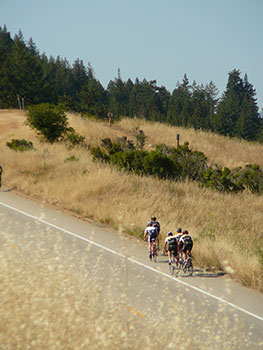 Pace Yourself. One of the most common mistakes is starting climbs at too fast a pace. Sometimes it's because it seems going hard at the bottom will give you a head start and make it easier to get over the top. Except for really short climbs, more rollers than true hills, the opposite is true: you should take it easy at the bottom and gradually go faster as you're closer to the top.
Pace Yourself. One of the most common mistakes is starting climbs at too fast a pace. Sometimes it's because it seems going hard at the bottom will give you a head start and make it easier to get over the top. Except for really short climbs, more rollers than true hills, the opposite is true: you should take it easy at the bottom and gradually go faster as you're closer to the top.
This is because if you start too hard you will tire early and be unable to sustain the effort. If you start easy you will find your rhythm and feel better as the climb goes on. So, always start out a bit slower than you think you can go. It takes a minute or two for your heart rate to catch up with your power output and beginning conservatively will prevent you from "blowing up." A few minutes into the climb you will feel better and be able to go faster if you wish.
To help find your climbing pace sweet spot, pay attention to the type of effort you can comfortably sustain in training. You can always go a bit above that, for example, if you're trying to keep up with a buddy who's pushing the pace, or hanging with a group on a climb.
Be clever, too! Try to conserve energy by drafting other riders (riding closely behind them to stay out of the wind and rest). That way you'll do less work on the run-in, and go into the climb more rested. If possible make sure you're eating and drinking enough in the half-hour before you hit the climbs so your stomach has time to digest and you have those calories to burn on the climb.
Lighten Up! It seems obvious, but you can really improve your climbing by dropping a few excess pounds. Climbing is essentially a struggle against gravity, and the less mass you have to lift, the easier it is to go uphill.
Just practicing climbing may provide the calorie burning you need to shed weight and that's a relatively easy and fun way to do it. Or, it might be as easy as looking at what you're eating and replacing any empty/junk calories with beneficial ones. Besides helping those extra pounds come off, combined with your cycling, it will make you feel and look better and better the longer you stick with it.
Lakeside Bicycles Can Help. We hope these tips help you get over the hills with ease. And, keep in mind that a perfectly running bicycle is important to climb well too. If you need a nice new bicycle, a tune-up to get Old Faithful shifting right again, or changes to your gearing to let you flatten the climbs on your next important ride, we're here to help!
